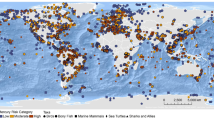Abstract
We determined mercury (Hg) concentrations in various tissues of Burmese pythons (Python bivitattus; n = 227) caught in southwest Florida from 2012–2018 as part of a program to control this invasive species. Mercury ranged as high as 4.86 mg/kg in liver tissue from a snake that was 4.7 m long but overall averaged 0.12 ± 0.19 mg/kg in tail tips (n = 123). These levels were relatively low as compared to concentrations reported in pythons from Everglades National Park, a recognized Hg hotspot. These results show that snakes, particularly watersnakes, present another opportunity to biomonitor Hg at the aquatic-terrestrial interface. Although capturing snakes presents obvious challenges, which differ from sampling other taxa typically used in monitoring programs, taking advantage of this program to control an invasive species was cost effective and alleviated concerns about sampling and possibly reducing native snake populations.




Similar content being viewed by others
References
Bartoszek IA, Andreadis PT, Prokop-Ervin C, Patel M, Reed RN (2018) Burmese python (Python bivittatus) diet and prey size. Herpetol Rev 49:139–140
Bhupathy S, Vijayan VS (1989) Status, distribution, and general ecology of the Indian Python (Python molurus molurus) in Keoladeo National Park, Bharatpur, Rajasthan. J Bombay Natl History Soc 86:381–387
Dorcas ME, Willson JD, Reed RN, Snow RW, Rochford MR, Miller MA, Meshaka WE Jr, Andreadis PT, Mazzotti FJ, Romagosa CM, Hart KM (2012) Severe mammal declines coincide with proliferation of invasive Burmese pythons in Everglades National Park. Proc Natl Acad Sci USA 109:2418–2422
Drewett DV, Willson JD, Cristol DA, Chin SY, Hopkins WA (2013) Inter- and intraspecific variation in mercury bioaccumulation by snakes inhabiting a contaminated river floodplain. Environ Toxicol Chem 32(5):1178–1186
Florida Department of Health (FDOH) (2018) Your guide to eating fish caught in Florida. https://www.floridahealth.gov/
Gilmour CC, Riedel G, Ederington M, Bell J, Gill G, Stordal M (1998) Methylmercury concentrations and production rates across a trophic gradient in the northern Everglades. Biogeochemistry 40(2–3):327–345
Hart KM, Cherkiss MS, Smith BJ, Mazzotti FJ, Fujisaki I, Snow RW, Dorcas ME (2015) Home range, habitat use, and movement patterns of non-native Burmese pythons in Everglades National Park, Florida, USA. Anim Biotelemetry 3:8
Krabbenhoft D, DeWild J, Tate M, Ogorek TJ, Hart K, Snow S, Demopoulos A (2012) Mercury bioaccumulation in pythons from the Florida Everglades Region. In: Presented at the 9th INTECOL international wetlands conference, Orlando, Florida, USA. June 3–8, 2012. Posted to https://conference.ifas.ufl.edu/INTECOL/presentations/041/1040%20Krabbenhoft.pdf. Accessed 31 March 2019
McCleery RA, Sovie A, Reed RN, Cunningham MW, Hunter ME, Hart KM (2015) Marsh rabbit mortalities tie pythons to the precipitous decline of mammals in the Everglades. Proc R Soc B 282:20150120–20150120
Orem W, Gilmour C, Axelrad D, Krabbenhoft D, Scheidt D, Kalla P, McCormick P, Gabriel M, Aiken G (2011) Sulfur in the South Florida ecosystem: distribution, sources, biogeochemistry, impacts and management for restoration. Crit Rev Environ Sci Technol 41:249–288
Porcella D, Zillioux E, Grieb T, Newman J, West G (2004) Retrospective study of mercury in raccoons (Procyon lotor) in south Florida. Ecotoxicology 13(3):207–221
Roelke M, Schultz D, Facemire C, Sundlof S, Royals H (1991) Mercury contamination in Florida panthers. In: Prepared by the technical subcommittee of the Florida Panther Interagency Committee
Rumbold DG, Niemczyk SL, Fink LE, Chandrasekhar T, Harkanson B, Laine KA (2001) Mercury in eggs and feathers of Great Egrets (Ardea albus) from the Florida Everglades. Arch Environ Contam Toxicol 41:501–507
Rumbold DG, Lange TR, Axelrad DM, Atkeson TD (2008) Ecological risk of methylmercury in Everglades National Park, Florida, USA. Ecotoxicology 17:632–641
Rumbold DG, Miller KE, Dellinger TA, Haas N (2017) Mercury concentrations in feathers of adult and nestling Osprey (Pandion haliaetus) from coastal and freshwater environments of Florida. Arch Environ Contam Toxicol 72(1):31–38
Sargalski T, Benn E (2013) How to make Burmese python nuggets. May 10, 2013. WLRN. https://www.wlrn.org/post/how-make-burmese-python-nuggets. Accessed 31 March 2019
Snow RW, Brien ML, Cherkiss MS, Wilkins L, Mazzotti FJ (2007) Dietary habits of the Burmese python, Python molurus bivittatus, in Everglades National Park. Florida. Herpetol Bull 101:5
Ware FJ, Royals H, Lange T (1990) Mercury contamination in Florida largemouth bass. Proceedings of the annual conference of the southeast association of fish and wildlife agencies 44:5–12
Willson JD, Dorcas ME, Snow RW (2011) Identifying plausible scenarios for the establishment of invasive Burmese pythons (Python molurus) in Southern Florida. Biol Invasions 13:1493–1504
Wixson JG (2013) Bio-accumulation of metals in an insular population of Florida cottonmouth snakes (Agkistrodon piscivorus conanti). MS Thesis, University of Florida, Gainesville
Acknowledgements
We would like to thank all the staff of the Conservancy of Southwest Florida that provided field or laboratory support on this project as field technicians, paid interns or volunteers, including: Ian Easterling, Katie King, Ken Flute, Anthony Flannigan, Michelle Bassis, Monica Lasky, Jaimie Kittle, Leif Johnson and Cailin Prokop-Ervin. We would also very much like to thank William Lee, an FGCU, intern that spent much time in the laboratory processing and running samples. We also thank research partners at the U.S. Geological Survey, Naples Zoo, Rookery Bay NERR, Collier Seminole State Park and Big Cypress National Preserve for their collaboration and private donors for their project support.
Author information
Authors and Affiliations
Corresponding author
Rights and permissions
About this article
Cite this article
Rumbold, D.G., Bartoszek, I.A. Mercury Concentrations in Invasive Burmese Pythons (Python bivitattus) of Southwest Florida. Bull Environ Contam Toxicol 103, 533–537 (2019). https://doi.org/10.1007/s00128-019-02670-6
Received:
Accepted:
Published:
Issue Date:
DOI: https://doi.org/10.1007/s00128-019-02670-6




